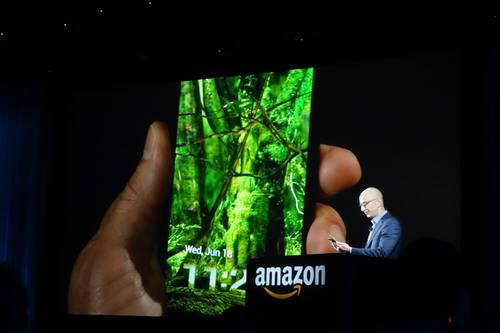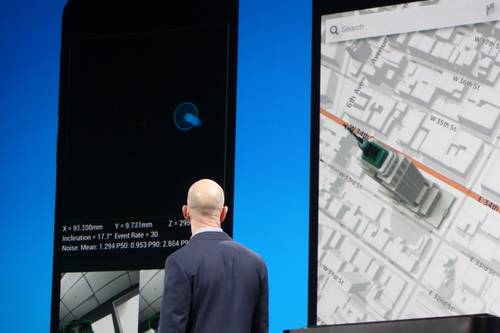It’s fair to call Amazon’s new Kindle Fire phone “3D”—but that sells the effect short compared to the 3D smartphone craze of yore and Apple’s dizzying iOS 7 antics. Amazon calls its 3D experience “dynamic perspective”—an apt if dull name for a pretty cool technical feat.
After spending some time exploring the Fire phone, the resulting phenomenon remains difficult to describe, but we’ll give it a shot anyway.
See also: Firefly Hands-On: 7 Ways Amazon’s Fire Phone Captures The Real World
Like all virtual 3D, dynamic perspective takes advantage of the human brain to “trick” us into sensing an additional dimension on a two dimensional surface. But unlike early glasses-free (technically, autostereoscopic) 3D televisions and other experiments in simulating the third dimension, Amazon’s technology doesn’t create a “pop-out” effect so much as a pop-in one. On the lock screen, for example, it looks as though you could actually peek around the Fire phone’s corners into what’s inside.
“We made special cameras that have a much wider field of view,” said Amazon CEO Jeff Bezos during the device’s launch event. “The key is knowing where the user’s head is at all times, in real time, many, many times a second.”

The Fire phone’s 3D certainly looks different, and that’s thanks to the inclusion of four—yes four—front-facing cameras, one in each corner. These front-facing, infrared-capable, “ultra low power” cameras track a user’s head position in real-time on the x,y and z axes, in combination with the parallaxphenomenon and other perspective considerations, resulting in Amazon’s unique 3D experience.

What Does Dynamic Perspective Do, Exactly?
The Fire phone’s new kind of sensor data enables some new kinds of gestures, like tilting the screen to “peek” at additional context menus, which pop in from the side. A swivel gesture (kind of cocking the phone at a 90 degree angle) pulls up a menu of quick actions and notifications, which felt surprisingly natural. A strange but kind of fun little touch is how app icons turn toward you as you move your head, as if begging to be tapped.

Another feature, hands-free scrolling, engaged by tilting the phone as it continues to track your head position, felt jerky and hyper-sensitive in our limited time testing the browser. The side menu gesture proved useful in maps, when peeking produced an overlay of location information, but we didn’t see too many other compelling applications for all of those fancy sensors—not yet, anyway. Still, without the need to occlude the UI with a touch gesture, it felt nice to have our screen real estate and eat it too.
Beyond UI functionality, we had a little time to play a snowboarding game controlled via head tracking, but the controls were rough around the edges in spite of the very responsive head tracking experience we’d seen in the UI. That said, the whole idea is for the experience to be as immersive and natural as possible, and there was definitely a learning curve.
A Risky Investment
Is dynamic perspective gimmicky? Ultimately, yes and no. The fancy lockscreen offers as much utility as iOS 7’s oft-untoggled 3D effects, but given Amazon’s inclusion of additional sensors there’s definitely opportunity there. Mobile game developers interested in investing in Amazon’s new platform could come up with some pretty cool experiences, though it’s far from clear they’ll feel like investing in a single proprietary platform like the Fire Phone.
See also: Amazon Fire Phone’s First Big Mistake: Cooperating With AT&T
Even if there are interesting opportunities for dynamic perspective on the horizon, Amazon’s choice to invest in sophisticated, undoubtedly pricey multi-camera head-tracking 3D system remains a head-scratcher. The Amazon we knew—the one that introduced the first Kindle Fire—would have skipped the fancy stuff and priced the Fire phone irresistibly low.
The Fire phone’s 3D experience is neat—and provides some actual utility, unlike most 3D—but we’re not convinced that it’s more than the sum of its parts.
And yes, for the record, you can toggle it off.
All photos and video by Taylor Hatmaker for ReadWrite

















